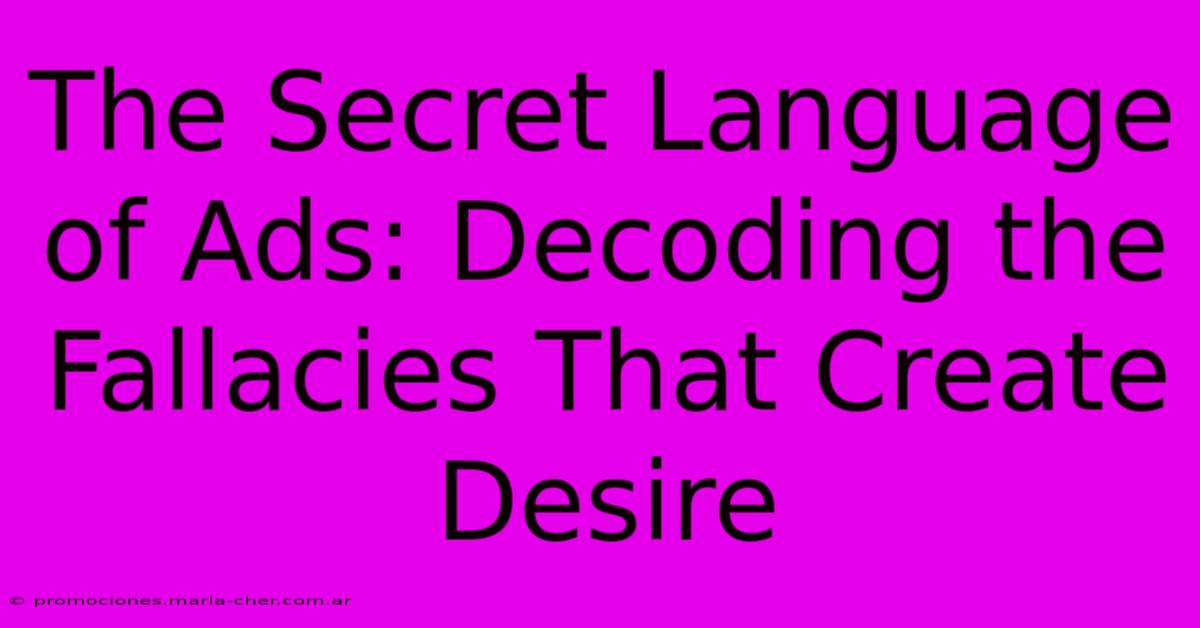The Secret Language Of Ads: Decoding The Fallacies That Create Desire

Table of Contents
The Secret Language of Ads: Decoding the Fallacies That Create Desire
Advertising is a powerful force, shaping our desires and influencing our purchasing decisions. But have you ever stopped to consider the language of advertising? It's not just about pretty pictures and catchy jingles; it's a carefully crafted system of persuasive techniques, often employing logical fallacies to create a sense of urgency and desire. Understanding these fallacies is the first step to becoming a more discerning consumer.
The Art of Persuasion: Logical Fallacies in Advertising
Advertising frequently leverages logical fallacies – flaws in reasoning – to manipulate our emotions and bypass our critical thinking. Let's examine some of the most common:
1. Bandwagon Effect: "Everyone's Doing It!"
This fallacy plays on our innate desire to conform. Ads showing throngs of happy people using a product imply that if everyone else is enjoying it, you should too. This taps into our social anxieties and the fear of missing out (FOMO). Example: An image of a crowded concert with everyone holding a specific brand of beer.
2. Appeal to Authority: "Experts Agree!"
This tactic uses endorsements from celebrities or supposed experts to lend credibility to a product, even if their expertise is irrelevant. We're more likely to trust a recommendation from someone we admire or perceive as knowledgeable, regardless of the actual product quality. Example: A doctor recommending a specific brand of vitamins, even if their medical expertise doesn't relate to the specific vitamin's effects.
3. False Dilemma: "It's Either This or That!"
This fallacy presents only two options, often painting one in a negative light to make the other seem superior. It simplifies complex choices, ignoring other viable alternatives. Example: An ad proclaiming "Choose our superior cleaning product or live with a dirty home!" This ignores other cleaning brands.
4. Hasty Generalization: "One Example Proves It All!"
This fallacy draws broad conclusions based on limited evidence. A single positive testimonial is presented as proof of overall product excellence, ignoring potential negative experiences. Example: A single customer review claiming a product is "life-changing" is used to market the product to a broader audience without considering other reviews.
5. Red Herring: "Distraction, Distraction!"
This tactic shifts focus away from relevant information to something irrelevant but attention-grabbing. Instead of discussing product features, the ad emphasizes a superficial detail, such as celebrity endorsement or flashy visuals. Example: A car commercial focuses on the sleek design and exciting soundtrack, ignoring important aspects like safety ratings or fuel efficiency.
6. Appeal to Emotion: "Tug at Your Heartstrings!"
This manipulative technique plays on our emotions – fear, joy, sadness, etc. – to sway our decisions, bypassing rational thought. Sad puppy commercials aiming to encourage pet adoption or ads that tap into our fears about getting old are prime examples. Example: An insurance commercial featuring a family's emotional reaction to a tragic accident to emphasize the importance of insurance.
Becoming a Savvy Consumer: Critical Thinking in the Age of Advertising
By understanding these common advertising fallacies, you can become a more discerning consumer. Don't let clever marketing tactics cloud your judgment. Question the claims, analyze the evidence, and remember that advertising's primary goal is to sell you something—not necessarily provide you with objective information.
Beyond the Fallacies: The Power of Storytelling in Advertising
While logical fallacies are often employed, advertising's success also stems from compelling storytelling. Brands craft narratives that resonate with our values, aspirations, and emotions. This emotional connection makes the product more desirable, surpassing mere functional benefits. Analyzing this storytelling aspect offers another layer of understanding in deciphering advertising's persuasive power.
Conclusion: Decoding the Message
The language of advertising is complex and subtle. By actively identifying and analyzing the persuasive techniques used, you can navigate the world of advertising with greater awareness and make more informed purchasing decisions. Learning to recognize these logical fallacies empowers you to resist manipulative tactics and make choices based on reason, not emotion-driven marketing strategies.

Thank you for visiting our website wich cover about The Secret Language Of Ads: Decoding The Fallacies That Create Desire. We hope the information provided has been useful to you. Feel free to contact us if you have any questions or need further assistance. See you next time and dont miss to bookmark.
Featured Posts
-
Elevate Your Printing Astonishing Results On Rolls 90640
Feb 07, 2025
-
Prepare To Be Amazed How Lumis Ai Will Change The Way You View Photography
Feb 07, 2025
-
Garden Or Garment Sewed Or Sowed The Grammar Dilemma
Feb 07, 2025
-
Rsvp Today Unlock A World Of Elegance With Our Luxe Adult Birthday Invitations
Feb 07, 2025
-
Beat Back Pain Without Breaking The Bank The Insiders Guide To Epidural Steroids
Feb 07, 2025
